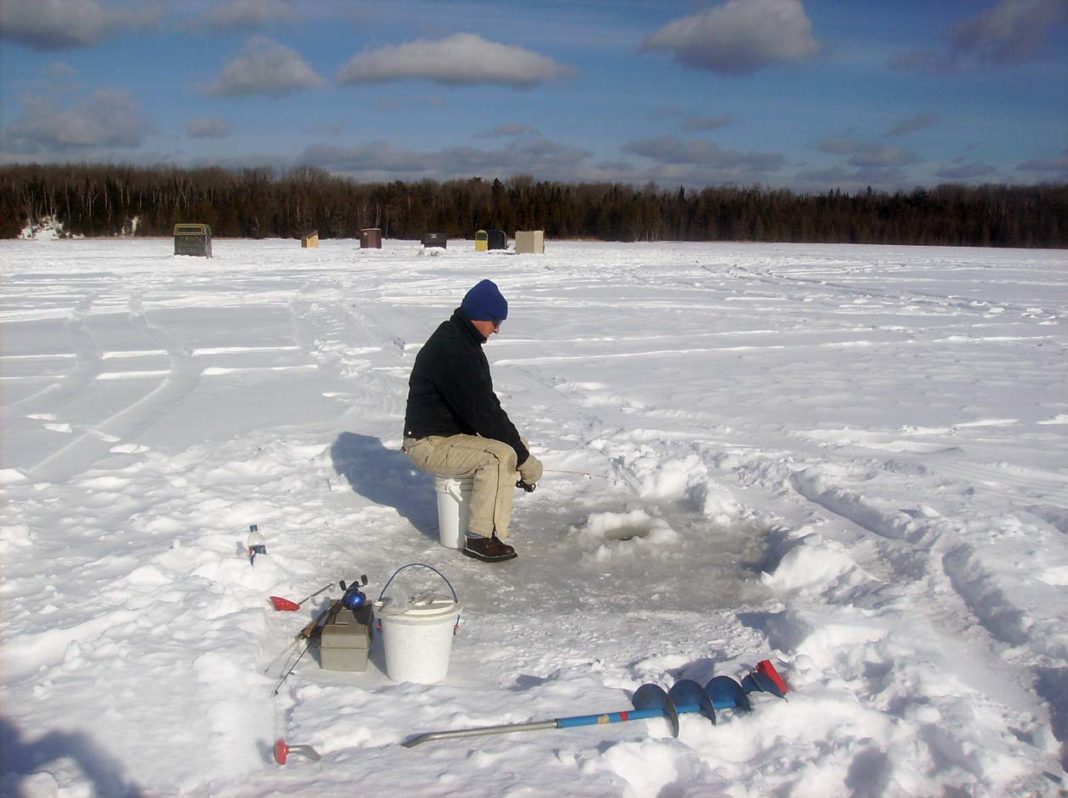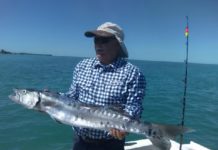Looking for a way to motivate yourself and your family to get outdoors this winter? Ice fishing might be just the thing. A relatively inexpensive form of winter recreation that continues to increase in popularity, ice fishing offers the benefits of exercise, fun for all ages, enough challenge to please the most competitive angler, and yet is easy enough that even a 5-year-old (with adequate supervision) can readily experience the excitement of catching fish through the ice. It can be pursued as a simple, solitary sport with minimal equipment and a high degree of mobility, or it can be enjoyed as a highly social activity with day-long encampments, portable chairs and shelters, outdoor cooking, and all the latest technological fishing gadgetry. Ice fishing offers excellent chances for catching trophy fish: Our Sportfishing Awards records indicate, for example, that 96% of largemouth bass over 8 pounds, 80% of yellow perch over 2 pounds, and 77% of northern pike over 20 pounds are taken through the ice. The best part, however, is that once you acquire the skills, you can often return home at the end of the day with enough fish for a tasty family dinner.
The first requirement to enjoy ice fishing is warm clothing. It’s hard to enjoy anything outdoors in winter if you aren’t comfortable, and this is particularly true for kids. Heavily insulated rubber boots or “pac boots” with removable felt liners are generally recommended for footwear, as these will not only keep your feet warm, but are also waterproof to resist the slush and water that often sits on the surface after heavy snow storms and temporary thaws. The rest of the clothing should be layered: long underwear, wool sweater, insulated pants or bib overalls, jacket/coat, and perhaps a vest and windbreaker. This allows you to take a layer or two off to stay cool while cutting holes and dragging equipment, and to replace them and stay warm while sitting and waiting for action. Top it all off with a pair of wool gloves and a hat with the option to cover your ears. A small towel for drying hands after baiting/handling fish, and a pair of warm, heavy mitts that can be slipped on even when hands are damp are very useful extras. Don’t forget sunscreen, sunglasses, lip balm and skin moisturizer: cold, dry, ultra-bright conditions make all four welcome accessories. We also recommend bringing along a supply of disposable hand/foot/body warmers for use when needed.
Fishing equipment starts with a tool for cutting holes in the ice. When the ice is less than 6-8 inches thick, an ice chisel or “spud” is perfectly adequate for the job, but when the thickness increases, an ice auger (drill) is the way to go. Spuds generally cost $25-$50, depending on quality, while hand augers range from around $45 to $100. The more expensive models are better designed and most anglers agree are worth the added cost. Most anglers use a 6- or 8-inch auger, although a jig fisherman who will be cutting dozens of holes in a day may want to go with a 4- or 5-inch model. The smaller the hole, the easier and faster the cutting, but remember we have some big fish out there and a trophy bass or northern pike won’t fit through a small hole. Power augers (gas- or battery-operated, $300-$600) are unnecessary in most situations, heavy to transport, and often prone to mechanical problems, but there are those who swear by them. They are probably the best option for those after big fish, because if you want a large-diameter hole (typically 9-12 inches) when the ice is over a foot thick, it is the only efficient option. Whatever tool you use to cut your holes, you will need an ice skimmer (basically a coarse sieve attached to a handle) to clean the hole of slush after you open it. Skimmers are available with a small chipper blade in the handle, a very useful tool for keeping holes open on cold days.
Once you have a way to reach the fish through the ice, all you need is the equipment to catch them. There are two main types: jigging rods and tip-ups. Jigging rods are simply short rods, usually around 18 inches long, equipped with a small spinning reel. Fill the spool with light monofilament or thin braided line; bait with a small, flashy jig that can be sweetened with a bit of earthworm, mealworm, or a perch eye; and you are ready to actively target perch, trout, bass, and panfish. Tip-ups, also known as tilts, are the standard stationary form of ice-fishing gear. There are many variations of tip-up designs, but they are all basically made to straddle an ice hole, hold a bait at a specific depth, and signal (usually with a small flying flag) whenever a fish takes the bait. Since Massachusetts anglers are allowed to have up to five hooks in the water when ice fishing, you should initially purchase a set of five or six tip-ups (having a spare on hand is always a good idea). Once you have some fully-rigged tilts, the only other equipment you need will be a bait bucket (to carry shiners); a sounding weight; and a sled, toboggan or pack basket of some kind to carry all your gear.
Jigging technique typically involves dropping the jig to the bottom and slowly moving it up and down until a biting fish is detected. Then the hook is set and the fish is reeled or hauled in. When trout or crappie fishing, jigging near the surface is often more productive than fishing near the bottom, where the perch and bass are usually found. When fishing with tilts, put 30-50 yards of braided or squidding line on the spool for backing (large-diameter line is easier to handle). Tie a barrel swivel to the end of the backing line, and then tie a 3-4 foot length of monofilament to the other end of the swivel. Most anglers prefer 6-8-pound test for the leader, but if the target is pike a heavy mono or wire leader may be necessary, and trout (especially brown trout) can be so leader-shy that you may have to drop to 4-pound test to fool them. Tie on a hook appropriate in size to the bait you are using, place a non-toxic split shot a foot above the hook to get the bait down quickly (optional), and you are ready to go. Send your sounding weight down to the bottom on your hook, and mark the depth on your line with a tiny bobber or button so you can get to the same depth again without sounding every time. Then re-spool your line, bait the hook, and set your tip-up so the bait will end up a foot or two off the bottom. Most anglers fish with 2-5-inch shiners, hooked either through the lips or just behind the dorsal fin. Now all you need to do is set the hook when a fish strikes, and play it well enough to slip it topside through the hole!
Finding a productive water to fish is never difficult. Make sure ice conditions are safe (waiting until you see other anglers on the ice is always prudent) before you go, and never take chances with thin (less than 4 inches thick) or questionable (partially melted) ice. To make the most of a family fishing outing, try to pick a day when winds will be light; wind (or rather the lack thereof) is the greatest predictor of how pleasant fishing conditions will be. Enjoy!









![The Best Deer Camp Chili [VIDEO] Deer Chili Ingredients, Tomatoes, Chili Spices](/wp-content/uploads/2015/10/Deer-Chili-Deer-Camp-Recipe-218x150.jpg)








![How to Call Elk Early in the Season [VIDEO]](/wp-content/uploads/2016/08/byers003-218x150.jpg)







![Idiots Disturb Hunter: How Would You Have Handled It? [VIDEO]](/wp-content/uploads/2015/10/DSC00110-e1474487693878-100x70.jpg)
![Albino Buck Shocked to Shed His Antlers [VIDEO]](/wp-content/uploads/2015/10/AlbinoDeer-100x70.jpg)